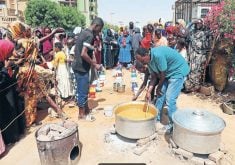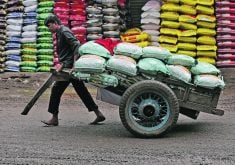The planet is becoming increasingly urbanized, but most of the world’s hungry continue to be rural based and depend on agriculture for their livelihoods.
“Despite the fact that the world is urbanizing at a frantic pace, the concentration of hunger is still predominantly a rural phenomena in many parts,” said Jim Cornelius, executive director of the Canadian Foodgrains Bank in Winnipeg.
“Our conclusion and analyses is that one of the key ways to reduce poverty and hunger is to, in fact, strengthen agriculture livelihoods and things related to the agriculture system.”
Read Also

Stacking Canada up on gene editing livestock
Canada may want to gauge how Argentina and other countries have approached gene editing in livestock and what that has meant for local innovation.
In December, the organization committed to 10 agricultural projects worth $3.28 million, which will benefit almost 100,000 people in 10 countries.
Many of the projects will be three to four years long and receive funding of $70,000 to $438,000 a year.
“Typically we’re doing about $37 to $38 million of programming in a typical year,” he said.
Countries include the Democratic Republic of the Congo, Nepal, Mozambique, Malawi, Liberia, Kenya, and Ethiopia.
The foodgrains bank comprises 15 members and their global partners.
The recently announced projects are being implemented by the Mennonite Central Committee, World Renew, Canadian Baptist Ministries, Evangelical Missionary Church of Canada, World Relief Canada, Presbyterian World Service and Development and the Canadian Catholic Organization for Development and Peace in collaboration with local partners.
Cornelius said a World Bank study concluded several years ago that the quicker the agricultural sector grows, the faster poverty declines.
“Growth in the agriculture sector does more to reduce poverty than growth in almost any other sector because of its employment creating effects,” he said.
“Ignoring agriculture and just seeing it as a backwater is not the right approach. We look at the development of many countries. It was built on developing a strong agriculture sector. That became the platform for industrialization and for reduction of poverty in the countries. But as we work at the longer-term solutions, we’re saying that we really do need to invest in how do we strengthen their livelihoods, and agriculture is one of the best vehicles for doing that.”
The foodgrains bank spends a significant part of its budget providing food to people facing chronic hunger, whether it’s because of conflict or natural disasters that have destroyed livelihoods.
One ongoing project is the war in Syria, which has displaced more than 10 million people, mostly city residents.
“Syria was a highly urbanized country in many ways, and a lot of the conflict is concentrated on the cities,” he said. “In the process, lots of people have lost their livelihoods. How do they feed themselves?”
Cornelius said the foodgrains bank also operates refugee programs in Lebanon and Jordan, which provided $8 million worth of assistance in the region benefitting more than 100,000 people.
“With these programs, you set them up for a five or six month period and then you have to review them because the context keeps changing,” he said.
“It’s a complicated story.”
william.dekay@producer.com















